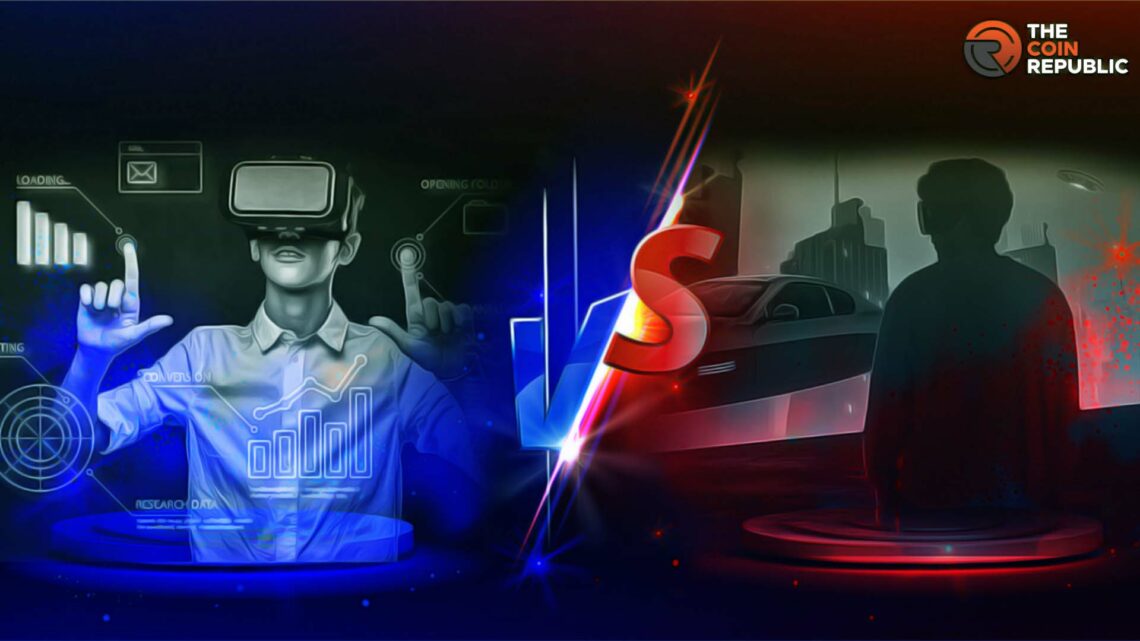- 1 Metaverse and Virtual Reality are two different concepts that are often confused to be the same.
- 2 Virtual reality is a computer-generated simulation while Metaverse is an open and shared virtual environment.
- 3 Five major distinctions between the Metaverse and VR.
The rapidly growing interest of famous companies like Facebook, Microsoft, has been flaming the buzz around ‘metaverse.’ Metaverse promises its users a three dimensional virtual space that is highly immersive and dynamic. Interestingly, the virtual experiences offered by metaverse are quite similar to the immersive features of the ‘traditional’ virtual reality world.
Since both techniques have the ‘virtual world’ as a common denominator, users assume that metaverse and VR are interchangeable. However, both metaverse and VR exhibit different concepts and some key differences.
Understanding Metaverse and VR
In broad terms, metaverse can be described as an online and shared 3D virtual realm that allows users to develop and share content. It is a network of interconnected 3D environments that can be managed and designed independently.
By moving freely inside these virtual worlds, users can play games, host conferences, attend concerts, customize avatars, and collaborate with colleagues. Moreover, adding blockchain technology to the mix, users can enjoy blockchain-based gaming and own digital currencies in the metaverse. The immersive experience of the metaverse can be accessed using VR devices (e.g., VR headsets, smart glasses), augmented reality (AR) devices, smartphones, and tablets.
On the other hand, virtual reality (VR) is defined as an immersive computer-generated simulation of a 3D environment with which users can interact. It provides users with a sense of being present in an immersive world where they can control things or conduct a series of actions.
VR is accessed through virtual reality head-mounted display (VR HMD) or a VR headset. It is worth noting that VR is one of the technologies that is used to create the immersive 3D environments of metaverse.
5 Key Differences Between Metaverse and VR
The significant disparities that exist between metaverse and VR are provided below:
- Accessibility of the Platforms
VR technology has been changing the landscape of technology for quite a long time. Various VR equipment companies like Sony, HTC, Valve, and others have made VR easily accessible to its users through platforms like Oculus Home, StreamVR, and Viveport.
Metaverse, in contrast to VR, is still in the infant stages of its development and therefore is not readily available in the market. However, many tech-giants, such as Facebook (Meta), Apple, and Microsoft, are striving to provide their users with a metaverse virtual experience.
- Technological Limitations
VR is a tremendous technological breakthrough that has changed the way we interact with others. However, there are still constraints on what we can achieve with the VR systems and it ultimately limits the extent of virtual world simulations that can be generated.
Metaverse, on the other hand, does not have these kinds of restrictions as it is supported by various technologies, such as AR, VR, crypto, blockchain, and other connectivity technologies. Moreover, metaverse can also be incorporated with other technologies to improve functionalities.
- Ownership Potential
When players opt for VR to have an immersive 3D experience, the VR systems they use and the content they experience are both owned by a brand. The only thing a player owns in this whole system is the VR equipment.
Conversely, metaverse provides its users with full ownership rights. Everything a player creates in this virtual world (e.g., digital assets, artifacts, virtual real estate, virtual experiences) solely belongs to them.
- Shared Experiences
The way users experience the virtual worlds of both VR and metaverse is quite different.
In the case of VR, users can feel they are wearing a headset through which they experience the 3D environment.
On the other hand, metaverse combines VR, AR, and other techniques to create a virtual world almost identical to the real world. Users, as a digital avatar, can move in the 3D network to play, interact, and collaborate with other users. They can also purchase and own digital assets and places in the virtual world.
The extent to which users can share their interactive virtual worlds in both VR and metaverse also differs. The virtual environment of VR is restricted to a certain number of people, e.g., player size in games. In contrast, metaverse is an open virtual world where players can travel, communicate, and visit other spaces in the metaverse without any confines.
- Persistence Capacity
Since it is far more developed than metaverse, there are many technologies with which the virtual world of VR can be experienced. However, these experiences shut down once the VR systems (e.g., headsets) are switched off.
Metaverse offers its users more in terms of persistence capacity as it is a shared universe. Having AR and other technologies as its core components, metaverse continues blending virtual and real experiences. Even if the user exits the metaverse, its digital avatar will stay in the virtual world and continue interacting with the other metaverse users.
To sum it up, both metaverse and VR are groundbreaking technologies that are aimed at enhancing the immersive experiences of the users. However, based on the above differences, the domain of VR has restraints and limited functionalities. Moreover, VR is just one component of the metaverse and there are plenty of other technologies that can be integrated with it to drive innovation.

Nancy J. Allen is a crypto enthusiast, with a major in macroeconomics and minor in business statistics. She believes that cryptocurrencies inspire people to be their own banks, and step aside from traditional monetary exchange systems. She is also intrigued by blockchain technology and its functioning. She frequently researches, and posts content on the top altcoins, their theoretical working principles and technical price predictions.


 Home
Home News
News






